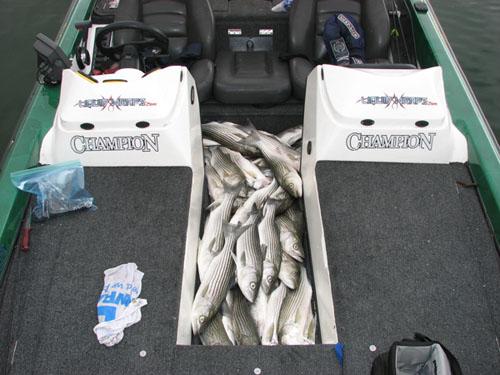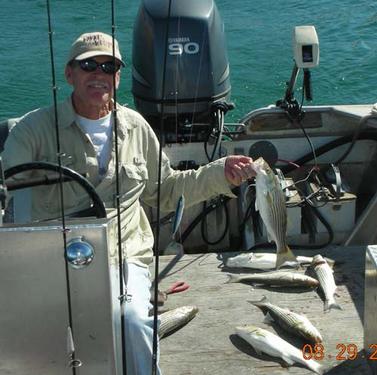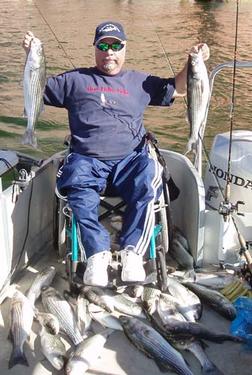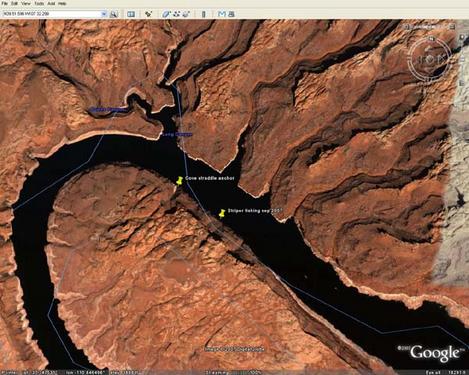Long Range Fish Report
From Sportfishing
From Sportfishing
Fish Report for 9-13-2007

Lake Powell Fish Report 09-13-07
9-13-2007
Wayne Gustaveson
It is readjustment time as the water begins to cool, the lake level continues to fall and predators try to find their next meal. Recent electrofishing sampling at San Juan and Rincon showed an eerie absence of shad or any small fish for that matter. All fish that were bite-size were hiding in thick cover of rooted aquatic weeds in less than 15 feet of water near shore. Some weed beds were quite tall and hid many fish. Those baby fish condos were constantly patrolled by hungry predators hoping "Nemo" would stick his head out too far.
Bass fishing was excellent around weeds which are fairly shallow at this lake level. A good strategy was to use a topwater lure over the weed tops in low light periods or toss a shallow running lure that would move through the weeds without hanging up. Spinner baits and weedless plastics like texas-rigged worms, senkos and flukes were ideal. Fishing shallow water along shoreline rocks was good for little smallmouth but the bigger fish were on the cliff walls or near weeds.
Neskahi Bay on the San Juan was excellent fishing as always. I was disappointed with the large number of thin bass here, as competition for food in this bay must be intense. There are way too many bass in Neskahi Bay. If fishing there, please harvest a limit of 20 smallmouth bass to reduce total fish numbers and help balance predator and prey numbers. Surprisingly, striped bass at Neskahi were 18-22 inches long and in good health. My guess is that stripers are able to feed on slightly larger prey while 10-inch smallmouth bass do not have large enough mouths to eat what prey is available. Small fish are gone or hiding in tight cover. Largemouth bass feed well in these circumstances but smallmouth suffer.
Further up the San Juan water clarity is murky beyond the Great Bend and into Zahn Bay. I did not find shad or game fish in the murky water. Alcove Canyon was good fishing for very healthy bass. It appears that poor bass condition is a localized event in Neskahi Bay. Striped bass are not often boiling now with shad numbers limited. Stripers find shad grouped up and boil two to three times each week. The rest of the time is spent searching. Stripers are very easy to see on the graph most often at the 30-40 foot strata. When a school is seen, drop a spoon to the bottom (40 feet), and reel quickly through the school pausing often. Without a graph the same success can be had by trolling a deep diving lure (Thunderstick or Mega Bait) in likely looking spots along points jutting into the main channel. When a fish is hooked try a spoon in that location or just troll over the same spot until they quit biting.
Bait fishing and night fishing is great. This week some new hotspots have been detected at the mouth of Knowles canyon, near Long Canyon in the main channel and Rock Creek in the lower lake. While fishing for bass, a chance encounter with a striper school allows a quick catch by trolling or spooning. Return to that spot with bait, especially at night with a green light to maximize the catch. Hundred fish trips are still common. The difference between now and springtime is striper size is smaller but fish health is much improved. Smaller, healthier fish offer a greater fight, and dinner when that time comes.
Fishing is slow when not tuned into the changes that have happened recently. Study this report and change your tendencies if necessary. Using last years techniques on the annual trip will not always bring success.
Bass fishing was excellent around weeds which are fairly shallow at this lake level. A good strategy was to use a topwater lure over the weed tops in low light periods or toss a shallow running lure that would move through the weeds without hanging up. Spinner baits and weedless plastics like texas-rigged worms, senkos and flukes were ideal. Fishing shallow water along shoreline rocks was good for little smallmouth but the bigger fish were on the cliff walls or near weeds.
Neskahi Bay on the San Juan was excellent fishing as always. I was disappointed with the large number of thin bass here, as competition for food in this bay must be intense. There are way too many bass in Neskahi Bay. If fishing there, please harvest a limit of 20 smallmouth bass to reduce total fish numbers and help balance predator and prey numbers. Surprisingly, striped bass at Neskahi were 18-22 inches long and in good health. My guess is that stripers are able to feed on slightly larger prey while 10-inch smallmouth bass do not have large enough mouths to eat what prey is available. Small fish are gone or hiding in tight cover. Largemouth bass feed well in these circumstances but smallmouth suffer.
Further up the San Juan water clarity is murky beyond the Great Bend and into Zahn Bay. I did not find shad or game fish in the murky water. Alcove Canyon was good fishing for very healthy bass. It appears that poor bass condition is a localized event in Neskahi Bay. Striped bass are not often boiling now with shad numbers limited. Stripers find shad grouped up and boil two to three times each week. The rest of the time is spent searching. Stripers are very easy to see on the graph most often at the 30-40 foot strata. When a school is seen, drop a spoon to the bottom (40 feet), and reel quickly through the school pausing often. Without a graph the same success can be had by trolling a deep diving lure (Thunderstick or Mega Bait) in likely looking spots along points jutting into the main channel. When a fish is hooked try a spoon in that location or just troll over the same spot until they quit biting.
Bait fishing and night fishing is great. This week some new hotspots have been detected at the mouth of Knowles canyon, near Long Canyon in the main channel and Rock Creek in the lower lake. While fishing for bass, a chance encounter with a striper school allows a quick catch by trolling or spooning. Return to that spot with bait, especially at night with a green light to maximize the catch. Hundred fish trips are still common. The difference between now and springtime is striper size is smaller but fish health is much improved. Smaller, healthier fish offer a greater fight, and dinner when that time comes.
Fishing is slow when not tuned into the changes that have happened recently. Study this report and change your tendencies if necessary. Using last years techniques on the annual trip will not always bring success.
Photos
< Previous Report Next Report >
More Reports
Lake Powell Fish Report 09-05-07
Lake Powell
9-5-2007
Summer is over. Lake Powell is quiet. Air and water temperature will now begin cooling to a more comfortable temperature...... Read More
Lake Powell Fish Report 08-22-07
Lake Powell
8-22-2007
My Goodness! Something happened to Lake Powel this week. The cause is uncertain but we know that yearling stripers that...... Read More

LongRangeSportfishing.net © 2025. All Rights Reserved.
Website Hosting and Design provided by TECK.net
Website Hosting and Design provided by TECK.net

